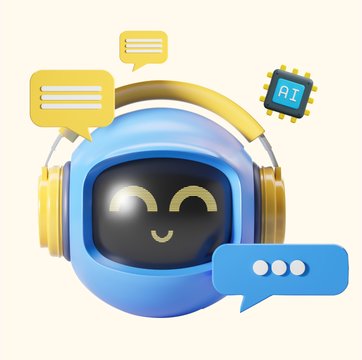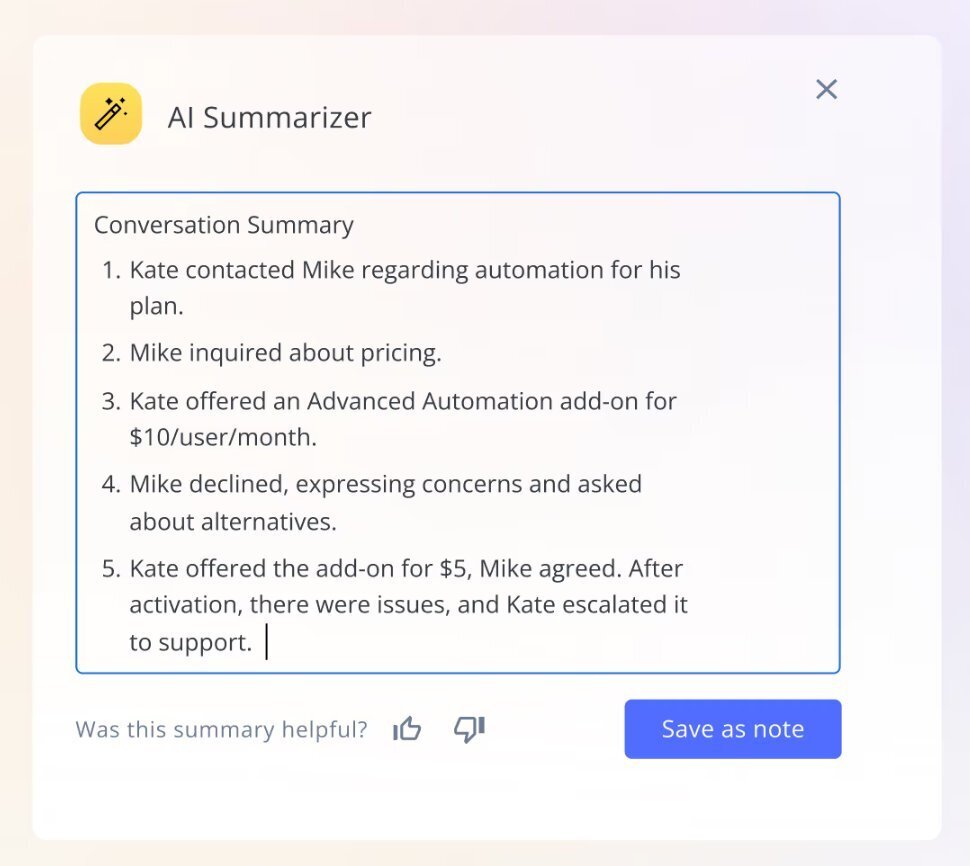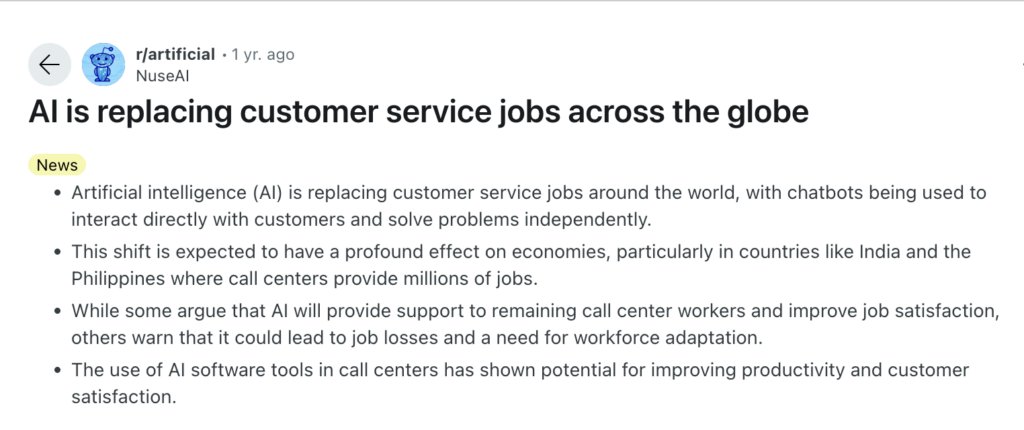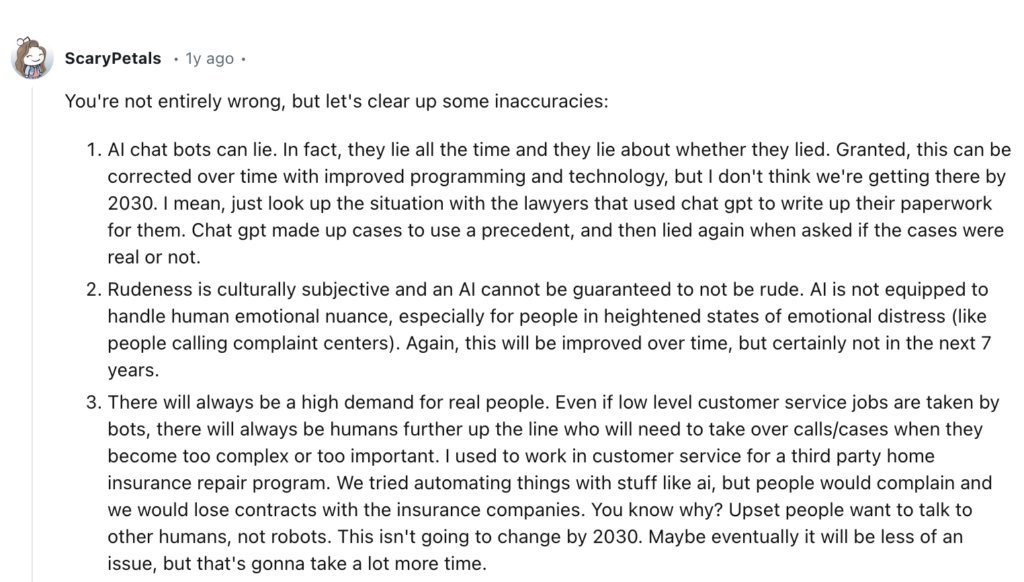How to Scale AI in Customer Service Without Losing the Human Touch

Table of contents
I recently bought a pair of earbuds from a well-known online store. However, I wasn’t able to pair them with my device, so I tried contacting their technical support.
However, the support bot wouldn’t connect me to a human representative and kept redirecting me to the FAQ page—which didn’t have my issue listed! After several failed attempts to reach an actual person, I gave up and returned the product.
I might get similar earbuds from any other store, but the business lost a customer – just because I couldn’t talk to a human!
This is not to say I’m against using AI in customer service. It’s definitely booming – and for the right reasons. With AI, support teams can offer faster responses and ensure 24/7 availability. But as my experience shows, scaling AI efficiently can be tricky. While it promises a lot, ethical considerations and maintaining a human touch are still important.
So, what’s the right way to scale AI in customer service? Let’s explore how to prepare your infrastructure, choose the right AI tools, and navigate ethical concerns like data privacy and human interaction. I’ll also share real-world case studies that show how to scale AI the right way.
Let’s dive into the exciting (and sometimes tricky) world of AI-powered customer service.
Table of Contents
- Ethical Implications of Scaling AI in Customer Service
- How to prepare for AI Scaling
- Strategies for Scaling AI in Customer Service
- Overcoming challenges in AI scaling
- Case Study: Successful AI Scaling in Customer Service
- Scaling AI with Empathy: The Right Balance for Success
- Frequently Asked Questions (FAQs)
Ethical Implications of Scaling AI in Customer Service
AI is revolutionizing customer service by making it faster, more efficient, and available 24/7. But, as AI continues to scale, concerns about its ethical implications are growing. One of the most hotly debated issues is the fear that AI will replace human jobs in customer service.
Here’s how a Reddit user expresses his opinion about AI replacing customer service jobs because these tools help improve productivity and customer satisfaction.
So, will AI truly replace customer service jobs?
It is easy to see why people think this way. AI can handle repetitive tasks at lightning speed and has been adopted by many companies to reduce costs.
But here’s the catch: customers still crave human interaction, especially when they’re frustrated or dealing with more complex issues.
In fact, a survey report by Hiver shows that 59% of support professionals believe in a human-led support strategy, valuing the empathy and personalized service humans provide.
Here’s a quote from another Reddit user who highlights AI’s inefficiencies. He explains how AI can sometimes show inaccurate responses and that it can never handle emotional nuances that require an empathetic response. Thus, the need for human intervention can never be diminished.
Thus, human agents will always be needed to perform tasks that require emotional intelligence and nuanced decision-making.
The balance: human touch still matters
So, what’s the right way to leverage AI? Hiver’s report on ‘AI vs Human Customer Service’ found that 60% of support professionals believe AI is excellent at automating tasks and providing recommendations.
Keeping this in mind, the use cases for AI becomes clearer. It can help with repetitive tasks like answering FAQs or tracking orders. The key part lies in balancing AI with human support staff – knowing when to automate something and when to provide human intervention.
Now that you know the importance of leveraging AI in the right places for your support operations, let’s discuss scaling AI in detail.
How to prepare for AI Scaling
Before you actually start scaling AI for customer service, you might want to take a step back and assess where you currently stand.
Implementing AI shouldn’t be done just for its own sake. It should enable you to create a seamless and efficient system that benefits both your team and your customers.
In fact, according to a recent report by Deloitte, 56% of businesses say they are not prepared for AI scaling due to outdated infrastructure. So, understanding your current capabilities is the first step to scaling successfully.
Now, let’s get into how to prepare your customer service infrastructure for AI scaling:
1. Assess your current customer service operations
Start by evaluating your existing setup. Are your systems equipped to handle AI integration? Do you have the bandwidth (both in terms of technology and team) to support AI-driven tools?
Many companies find that their systems struggle to integrate properly with newer AI platforms. In fact, a McKinsey study shows that companies with modernized infrastructure are 40% more likely to scale AI successfully.
Pro tips:
– If your current infrastructure isn’t up to speed, now is the time to consider upgrades that can support AI’s unique needs, such as data processing and cloud computing.
– Consider investing in a help desk solution if you haven’t already. Help desks are designed to integrate AI functionalities more seamlessly compared to traditional shared inboxes. Plus, many modern helpdesks come with built-in AI features. This streamlines your operations and makes customer support more efficient.
2. Identify key areas for AI implementation
Not every part of customer service needs AI. Start by identifying areas where AI can have the most significant impact. Think about the repetitive tasks that slow your team down—things like handling FAQs, processing basic inquiries, or even managing appointment bookings.
Pro tip: Prioritize implementing AI in cases where the volume of customer queries is high, and the nature of queries are quite straightforward.
Take Sephora, for example. They use AI chatbots to handle common inquiries on store timings, order statuses, and product availability, which frees up their support team to focus on more complex tasks like personalized beauty consultations.
This approach has helped them manage high volumes of inquiries while maintaining the personalized touch that customers need.
3. Set clear objectives and KPIs
Before rolling out AI solutions, set clear objectives around what you want to achieve. Are you looking to reduce first response time to 30 seconds? Do you want to improve customer satisfaction scores by 15% while lowering operational costs? Whatever your goal, set measurable KPIs to track progress.
With these clear objectives in place, you can ensure that your AI scaling efforts are aligned with your business goals and provide measurable ROI.
Recommended read: The Complete Guide to Customer Service Best Practices
Strategies for Scaling AI in Customer Service
The efforts needed to scale AI in the service operations differ from business to business and the KPIs you choose. There’s no one-size-fits-all approach to this. It requires choosing the right tools and strategies to ensure efficiency without sacrificing customer satisfaction.
Whether it’s implementing chatbots or an AI Summarizer – a feature that helps turn long email conversations into concise notes – each strategy must be thoughtfully planned and executed. In this section, we’ll look at how you can effectively scale AI in customer service:
1. Implement chatbots and virtual assistants
When it comes to chatbots, choosing the right platform is vital You need a platform with powerful AI capabilities that can handle your specific business needs. It should also be capable of learning and improving over time.
Chatbots are useful for handling straightforward inquiries at scale. But before you go into the market to invest in one, you need to look at what kind of questions you want the chatbot to answer. You also need to know if the bot is capable of learning and improving over time.
For instance, platforms like Intercom offer an AI chatbot called Fin that provides contextually relevant esponses based on customer behavior and past interactions.
Although such AI features make Intercom pretty expensive, users find these features quite useful.
Here are some tips that can help you find and implement a good AI chatbot:
- Start by evaluating the platforms on their ability to integrate with your existing systems. This will ensure seamless interactions between your AI and human support staff.
- Training the AI is also essential for optimal performance. Begin by feeding it with common inquiries and relevant datasets. Then, continue to monitor and tweak the chatbot’s responses to ensure that they provide accurate and contextually relevant solutions.
2. Leverage AI for Managing Emails
Handling emails can be one of the most repetitive and time-consuming tasks for customer service teams, but AI can change that dramatically. With the right tools, AI can not only organize and prioritize emails but also draft accurate responses to common queries, freeing up time for your human agents.
- Use AI tools to automate routine responses. Hiver’s Free AI Email Writer, for instance, can generate email responses in seconds. Whether it’s composing a new email or responding to a query, the tool offers suggestions based on your prompts.
- Categorize and prioritize incoming emails. AI can automatically sort through your inbox, flag urgent emails, and push them to the top of the queue. This ensures that your team spends time on the emails that truly need human attention. For example, platforms like Reply.io and Hiver allow you to set up automations that prioritize time-sensitive or high-impact emails.
- AI can help automatically close conversations that don’t need further action. Tools like Hiver come equipped with AI bots that recognize customer responses with “thank you” sentiments and other closure cues. Once detected, the system closes these conversations without needing any human intervention. This streamlines the process and frees up the time for more pressing tasks.
Recommended read: Customer Service Automation: Pros, Cons, and Best Practices
3. Integrate AI with Human Support Teams
AI isn’t meant to replace human agents—it’s there to enable people to work efficiently. The real magic happens when AI and humans work together seamlessly. While chatbots handle routine tasks, human agents should be empowered to handle customer interactions that aren’t quite straightforward.
- Use AI as a first-line filter. Allow chatbots or AI assistants to handle simple tasks, but ensure they can hand over complex cases to human agents efficiently. For example, at Lemonade, their AI assistant Maya handles initial claims processes, but human agents take over for more nuanced issues.
- Ensure smooth handoffs between AI and human agents. AI tools should provide agents with the context of the conversation so customers don’t have to repeat themselves, improving the overall customer experience. AI summarizer tools become helpful in such situations.

Overcoming challenges in AI scaling
From keeping customer data secure to maintaining a balance between AI and human support, businesses may face quite a few challenges.
1. Addressing data privacy and security concerns
Data privacy is a massive concern when it comes to AI. That’s because AI systems need to process large amounts of customer information. With regulations like GDPR and CCPA, businesses have to be extra careful about how data is collected, stored, and used.
Here’s what you can do to protect customer data:
- Implement end-to-end encryption. Ensure that customer data is encrypted during both transmission and storage. This will protect sensitive information from potential breaches.
- Make transparency a priority. Clearly communicate to customers how their data is being used. Also, offering an option for an easy opt-out for data collection can build trust.
- Regularly audit your AI systems. Conduct routine security assessments to identify vulnerabilities in your AI infrastructure and patch any gaps. According to IBM, 54% of companies faced data breaches due to misconfigured AI or machine learning tools. So, being proactive about data security is super important.
2. Managing the Human-AI Balance
While AI can handle routine tasks quickly, maintaining the human touch in customer service is still essential. In fact, according to Hiver’s report, 52% of customers prefer interacting with humans over AI because of the empathy angle.
This highlights the importance of finding the right balance when scaling AI in customer service.
- Let AI handle repetitive tasks like answering FAQs or processing simple requests, but ensure human agents are available for more nuanced interactions. Customers still value empathy and personalized service, which AI alone can’t fully deliver. Atleast, not yet.
- Train your support team to work alongside AI tools. AI can suggest responses and provide relevant customer data, but human agents should add a personal touch.
- Ensure seamless handoffs between AI and human agents. When a customer’s issue becomes too complex for AI to handle, it must transition the customer to a human. What’s important when this happens is that the context of the discussion should also be passed along. This ensures that customers don’t have to repeat themselves.
Recommended read: 18 Key Customer Service Metrics + How to Use Them
Case Study: Successful AI Scaling in Customer Service
One of the most successful stories of AI scaling in customer service comes from Lemonade, a tech-driven insurance company that has fully embraced AI to streamline customer interactions. The company developed its own AI assistant, Maya, who plays a critical role in handling the initial stages of claims processing.

Here’s how they made it work:
- AI manages more than 30% of claims: Lemonade’s AI handles more than 30% of its claims instantly, without human intervention. This has allowed the company to scale operations quickly. It is also important to note that they don’t completely depend on AI. Whenever there is a need, human support staff jump in to help customers. This way, they maintain a good balance between human and AI intervention.
- Claim processing time reduced to 3 seconds: Maya can process straightforward claims in just as little as three seconds. This massive reduction in time has made a huge impact on customer satisfaction.
This case demonstrates how businesses can effectively scale AI in customer service by automating routine tasks while keeping humans at the helm for more complex issues.
Scaling AI with Empathy: The Right Balance for Success
Scaling AI in customer service has huge potential—it can boost efficiency, offer 24/7 availability, and handle high volumes of routine tasks. But if it’s not done right, you risk frustrating customers and losing their trust, just like the earbuds fiasco I shared earlier.
To scale AI successfully, you need to focus on balance. Use AI where it excels, but make sure your human agents are there when customers need empathy or personal attention.
In short, scaling AI in customer service is a journey—one that, when done thoughtfully, can bring big rewards. Just make sure you’re not leaving your customers (or their needs) behind in the process.
Frequently Asked Questions (FAQs)
- Can AI fully replace human agents in customer service?
No, AI can’t fully replace human agents—nor should it. While AI is great for handling repetitive tasks like answering FAQs or processing basic queries, human agents are still essential for complex or emotionally sensitive issues. Customers often want a real person when things go beyond basic troubleshooting.
- How do I decide what parts of my customer service should be automated with AI?
Start by identifying the most repetitive and time-consuming tasks your team handles, like answering common questions or processing simple requests. These are prime candidates for automation. More complex or unique cases that require human judgment or empathy should be handled by human agents.
- Do AI chatbots actually improve customer satisfaction?
It may, but it depends on how they’re used. When AI chatbots are well-trained and handle common tasks quickly and accurately, they can improve satisfaction by reducing wait times. However, if they’re overused or prevent customers from reaching a human when needed, they can hurt satisfaction. It’s all about balance!
- How do I ensure a smooth handoff between AI and human agents?
To ensure a smooth handoff, your AI should be able to pass on full context—like the conversation history or customer issue—to the human agent. This way, the customer doesn’t have to repeat themselves. Seamless integration between AI and your CRM or helpdesk systems can make this process much smoother.
- How can I ensure my AI system stays up to date?
AI systems should be regularly updated with new data and continuously monitored to ensure they’re providing accurate responses. This means retraining the AI as your product or services evolve and making sure it reflects the latest customer queries or issues.




































